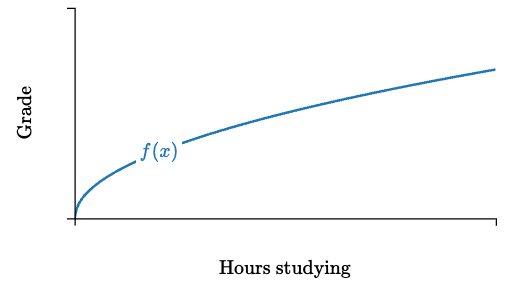Welcome to Econ 50
Christopher Makler
Stanford University Department of Economics
Econ 50: Lecture 1
Today's Agenda
Introductions
Course Overview
Course Structure and Policies
Math Fluency and Sketching Graphs
Introductions
Chris Makler
- B.A.: Humanities, Yale
- Ph.D.: Economics, Penn
(search & matching theory)
- 10 years in the education technology industry
- Teaching Econ 50 & 51 since 2015
- Office: Landau Econ Building, Room 144
Welcome to Econ 50!

pollev.com/chrismakler

What are you planning on majoring in?

Why are
you here?

It's probably not the sexiness of the course description:
It probably is that this course is a prerequisite for a lot of other courses.
...but why?
Ways to Think about Learning
Strategic:
"knowing when" - given an unstructured problem, which model/framework is most relevant?
Schematic:
Procedural:
Declarative:
"knowing why" - how do different concepts/models relate to one other?
"knowing how" - given a well-defined problem, ability to follow correct procedure to solve it
"knowing that" - facts and figures, vocabulary
Goals of the Course
Strategic:
Develop rigorous approach to economic modeling; understand how assumptions map into conclusions.
Schematic:
Procedural:
Declarative:
Understand the relationships between
words, math, and graphs.
Learn the techniques of
optimization, equilibrium, and comparative statics.
Know the definitions of key economic terms.
The overall goal of this course is to prepare you
for all the courses -- and jobs -- that build upon this material...
...by providing you with technical training to solve problems...
...and the ability to take an unstructured situation in the real world
and convert it into a structured, solvable problem.

It's about learning how to use
the "building blocks" of economic models
to construct models of things you're interested in.
It's not about the particular models
we're looking at in this class.
Course Overview
Two Kinds of Optimization
Tradeoffs between two goods
Optimal quantity of one good
🍎
(not feasible)
(feasible)
🍌
Optimal choice
🙂
😀
😁
😢
🙁
🍎
benefit and cost per unit
Marginal Cost
Marginal Benefit
Optimal choice
Two Kinds of Optimization
Tradeoffs between two goods
Optimal quantity of one good
- Modeling consumer preferences
with multivariate calculus - Utility maximization subject to a budget constraint
- Consumer demand
Midterm 1: April 25
- Cost minimization
- Firm profit maximization and supply
- Competitive equilibrium
Midterm 2: May 16
Model: Consumer Choice
Models: Firms, Markets
Remaining 2-3 weeks: real-world applications of these models
Course Structure and Policies
Modules
Monday
Tuesday
Wed
Thu
Fri
Lecture
Lecture
Lecture
Problem Set Due
Section
Section
TA OH
TA OH
Makler OH
Office hours will be posted on the syllabus when we have rooms booked...probably later this week.
Before Lecture
- Read the textbook and take online quizzes on the major points to be prepared for learning in lecture
Lecture
- Presents new ideas
- Illustrate those ideas with simple examples
After Lecture
- Exercises for each lecture are designed to help you understand nuance
- More complex examples and applications than in lectures; work on connecting the dots
After Each Unit
- Exam questions will ask you to apply concepts from lecture to new situations you haven't seen before.
Pre-Class Quizzes (5% of your grade)
-
Purpose: help you get the most out of lecture by providing an incentive to
read the textbook before class -
I do not expect you to fully learn the material by reading the textbook.
Just familiarize yourself with what we'll be talking about. -
20 percentage point "boost": if you get 80% or more right becomes 100%,
70% becomes 90%, etc. -
Realistically, as long as you come to most classes and put in effort
into each of the quizzes, these don't affect your grade.
Homework (30% of your grade)
-
Due most Tuesday nights; automatic grace period until 8am Wednesday morning.
-
Each exercise (including old exam questions) is worth 3 points.
- The grade is a message:
-
3 points (check-plus): You've got this!
-
2 points (check): You should review the solution set.
-
1 point (check-minus): You should review this material.
-
-
You do not have to do them all. Recommend doing about 2 problems per lecture (6/pset).
-
Full credit (100 points total) for 12.5 points per problem set.
-
Maximum 16 points per problem set.
-
No homeworks accepted after 8am morning after due (automatic grace period until then)
-
You must assign pages in Gradescope to get your work graded!
pollev.com/chrismakler

If you don't have much time for homework, what should you do?
Midterm Exams (30% of your grade)
-
Fridays of Week 4 and 7
-
Meant to be a way for you to self-assess and keep on track
-
Two exams means that the stakes are lower for each one. Plus:
-
Higher score is 20% of your grade
-
Second highest score is 10% of your grade
-
-
Exams are not optional! Do not schedule personal travel or anything else that would require you to miss an exam.

Final Exam (35% of your grade)
-
Friday, June 6 at 3:30pm (set by University)
-
You must take the exam here in person unless you're traveling on Stanford business, or if you've started a summer job or internship; sorry.
-
If you have a summer job or internship, you are responsible for finding someone official to administer and proctor the test concurrently with the rest of the class. We need to know who that's going to be by the end of Week 8.
-
If you have to miss the final due to illness or emergency, you may take an Incomplete only if:
- Your average midterm grade is a C or better, AND
- You have a (curved) score of at least 80% on your quizzes (so a raw score of at least 60%), AND
- Your homework score is at least 80 points
Class participation
We don't take attendance in lectures or sections.
However, everything we cover in lecture and section is fair game for exams.
Lecture and section notes will be posted, but you'll do better on exams if you come to class.
PollEverywhere questions in class are meant to make lecture a bit more interactive and fun.
They do not count officially for your grade, but if you're on the border between two grades...
I will do my best to make lecture entertaining and informative.
I rely on your help in the care and maintenance of the vibe.
This means no laptops, phones (except PollEv), or tablets (except to take notes on).
Friday, May 16
Midterm 2
Friday, April 25
Midterm 1
Friday, June 6
Final Exam
3:30pm
THESE ARE THE EXAM DATES.
DO NOT SCHEDULE ANYTHING THAT FORCES YOU TO MISS AN EXAM!!!
PUT THEM IN YOUR CALENDAR.
Course Web Sites
All content is posted/linked within Canvas.
Each week has its own module with everything you need to know about that week.
Please use Ed Discussions to ask questions (not email).
Please submit homeworks via Gradescope.
Helpful videos from UCSD are available for free, courtesy of UCSD.
Link in the syllabus; videos corresponding to each class will be posted on the syllabus and on ED.
Econ Department Peer Advising
Other Resources
VPTL Peer Tutoring
IMVH Video Handbook
Advice for You from Former Students (from course evals)
"Be prepared for the psets to be fairly more difficult than the examples worked out during lecture.
Sometimes there might be a disconnect between lecture and psets, too."
| "Class is difficult, but there are so many resources available to help you. Make use of office hours." |
"It's a lot of work, but if you stay on top of it, you'll be fine.
Definitely recommend doing all the psets and as many past exam questions as you can.
Makler's exam kinda made me want to cry, but everyone walked out kinda wanting to cry, so it's okay, probably."
"Organized, streamlined, and despairingly efficient.
This class crunches through concepts and ideas faster than you can get a good grip of them.
Makler is very approachable with questions, however, even if he memes on us a lot."
"...If you can, take the course together with your friends; they may be a great resource in helping you
grasp the course concepts! If you decide to take ECON 50, I hope you have a great time
and that you find a close-knit community of fellow enthusiasts of Economics."
The Small Print
- Names and pronouns
- Students with documented disabilities
- Stanford University Honor Code
- Econ Department syllabus
- Humor gone wrong
Office Hours
- Come to office hours! Starting later this week...watch ED for details.
- Try your hand at the homework before coming to office hours; don't just come and do the homework in front of me. Then come with points of confusion and we'll talk through it.
50 vs. 50Q
BA vs. BS
New for this year!
Spring 2025 Redesign

B.A. Core Requirements
B.S. Core Requirements
You may take either 50 or 50Q and still choose to declare as a B.S.
You need to take more rigorous math and statistics courses for the B.S.:
specifically, Econ 102A is not a Core course for the B.S.!

TA Intros!!!
Fluency in Math
pollev.com/chrismakler

Suppose \(a\), \(b\), and \(c\) are strictly positive constants.
Which of the following is a graph of \(ax+by=c\)?
(A)
(B)
(C)
(D)

Again suppose \(a\), \(b\), and \(c\) are strictly positive constants.
Which of the following shows the effect of an increase in the parameter \(a\)?
(A)
(B)
(C)
(D)
The four dashed lines below show the line \(ax+by=c\)
Parallel shift out
Parallel shift in
Pivot out
Pivot in

Again suppose \(a\), \(b\), and \(c\) are strictly positive constants.
Which of the following shows the graph of the implicit function \(a\ln(x) + b\ln(y) = c\)?
(A)
(B)
(C)
(D)
Concave, upward sloping curve
Convex, upware sloping curve
Concave, downward sloping curve
Convex, downward sloping curve
Ways of Describing a Model
Verbally
Mathematically
Visually
Diminishing marginal returns:
as you do more of something
(e.g. study)
you get fewer and fewer results
(e.g. more points on an exam)

Diminishing marginal returns:
as you do more of something
(e.g. study)
you get fewer and fewer results
(e.g. more points on an exam)
Diminishing marginal returns:
as you do more of something
(e.g. study)
you get fewer and fewer results
(e.g. more points on an exam)
What does "diminishing marginal returns" mean?
Diminishing marginal returns:
as you do more of something
(e.g. study)
you get fewer and fewer results
(e.g. more points on an exam)
What does "diminishing marginal returns" mean?
This has the same sign as \( (a -1) \)
Sketching a Function
What are the critical points of this function?
How could you go about sketching this function?
Before next class
Make sure your assigned section time works for you;
if not, submit the form for a change of section time.
Read the lecture notes for lecture 2 and take the quiz!
Optional: do some Khan Academy exercises
Econ 50 | Spring 25 | Lecture 01
By Chris Makler
Econ 50 | Spring 25 | Lecture 01
Welcome to Econ 50
- 746



